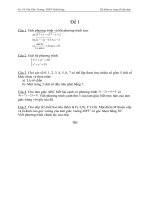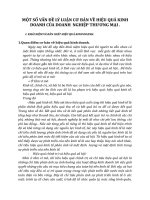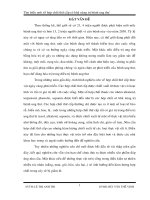mae 101 fpt fall 2019 nguyenvantien0405
Bạn đang xem bản rút gọn của tài liệu. Xem và tải ngay bản đầy đủ của tài liệu tại đây (563.1 KB, 32 trang )
<span class='text_page_counter'>(1)</span><div class='page_container' data-page=1>
<b>Chapter 3</b>
</div>
<span class='text_page_counter'>(2)</span><div class='page_container' data-page=2>
<b>OUR GOAL</b>
o <sub>How to find the </sub><b><sub>determinant</sub></b><sub> of a square </sub>
matrix?
</div>
<span class='text_page_counter'>(3)</span><div class='page_container' data-page=3>
<b>Determinant of a square matrix</b>
• <sub>Determinant</sub><sub> of an nxn matrix A are </sub>
denoted by det(A) or |A|.
• <sub>For 2 x 2 matrices:</sub>
Or
</div>
<span class='text_page_counter'>(4)</span><div class='page_container' data-page=4>
• <sub>3 x 3matrices:</sub>
det(A) =
<b>+</b>a.det <b>-</b> b.det <b>+</b> c.det
= aei – afh – (bdi – bgf) + cdh – cge
</div>
<span class='text_page_counter'>(5)</span><div class='page_container' data-page=5>
<b>Example </b>
</div>
<span class='text_page_counter'>(6)</span><div class='page_container' data-page=6>
<b>The </b>
<b>determinant</b>
<b> of 3x3 matrix (only)</b>
+
+ +
<b></b>
<b></b>
<b></b>
-
-3
2
2
-2
0
1
2 2
1 <i>col</i> <i>col</i>3 1 <i>co</i>
<i>a</i> <i>b</i> <i>c</i> <i>a</i> <i>b</i>
<i>d</i> <i>e</i> <i>f</i> <i>d</i>
<i>col</i> <i>col</i> <i>l</i>
<i>e</i>
<i>g</i> <i>h</i> <i>i</i> <i>g</i> <i>h</i>
</div>
<span class='text_page_counter'>(7)</span><div class='page_container' data-page=7>
<b>Definition</b>
If A is an mxm matrix then the <b>determinant</b> of A is
defined by
• <b>detA</b>=a<b><sub>i</sub></b><sub>1</sub>c<b><sub>i</sub></b><sub>1</sub>(A)+a<b><sub>i</sub></b><sub>2</sub>c<b><sub>i</sub></b><sub>2</sub>(A)+…+a<b><sub>i</sub></b><sub>m</sub>c<b><sub>i</sub></b><sub>m</sub>(A)
• or <b>detA</b>= a<sub>1</sub><b><sub>j</sub></b>c<sub>1</sub><b><sub>j</sub></b>(A)+a<sub>2</sub><b><sub>j</sub></b>c<sub>2</sub><b><sub>j</sub></b>(A)+…+a<sub>m</sub><b><sub>j</sub></b>c<sub>m</sub><b><sub>j</sub></b>(A)
1 2
1 5
6
4
0
0 6
4
0
1 7
1 0
68
0 7
1 0
1
8
2
0 1
8
2
11 12 13
(1,1) (1,2) (1,3)
det . . . .
<i>cofactor</i> <i>c</i>
<i>a</i> <i>a</i> <i>a</i>
<i>cofactor</i>
<i>ofactor</i>
<i>e</i> <i>f</i> <i>d</i>
<i>a b c</i>
<i>a</i> <i>f</i> <i>d e</i>
<i>A</i> <i>d e</i> <i>f</i>
<i>h</i> <i>i</i> <i>g</i> <i>i</i> <i>g h</i>
<i>g h</i>
<i>c</i>
<i>i</i>
</div>
<span class='text_page_counter'>(8)</span><div class='page_container' data-page=8>
<b>The determinant of triangular </b>
<b>matrices</b>
</div>
<span class='text_page_counter'>(9)</span><div class='page_container' data-page=9>
<b>Examples </b>
Find det(A), det(B), det(AB), det(A+B)
• <sub> </sub>
det(A.B) = det(A).det(B)
</div>
<span class='text_page_counter'>(10)</span><div class='page_container' data-page=10>
<b>Examples</b>
• <sub>Find det(A), det(3A), det(A</sub>2) if
• <sub> </sub>
o<sub> det(cA) = c</sub>ndet(A)
</div>
<span class='text_page_counter'>(11)</span><div class='page_container' data-page=11>
<b>Properties </b>
For all nxn matrices A, B:
o <sub>det(A.B) = det(A).det(B)</sub>
o <sub>det(kA) = k</sub>ndet(A)
o det(AT) = det(A)
o <sub>det(A</sub>-1) = 1/det(A)
</div>
<span class='text_page_counter'>(12)</span><div class='page_container' data-page=12>
<b>The determinant of triangular </b>
<b>matrices</b>
</div>
<span class='text_page_counter'>(13)</span><div class='page_container' data-page=13>
<b>Examples </b>
o Find the determinants
// from A, interchange row 1 and row 2
// from A, -2.(row 1)
</div>
<span class='text_page_counter'>(14)</span><div class='page_container' data-page=14>
<b>Examples </b>
o Find the determinants
And
The second matrix is obtained from the first matrix
by (2*row1 + row3), they have the same
</div>
<span class='text_page_counter'>(15)</span><div class='page_container' data-page=15>
<b>Determinants and elementary </b>
<b>operators</b>
1. Đổi chỗ 2 dòng (hoặc 2 cột) cho nhau,
matrix thu được và matrix ban đầu có
định thức trái dấu nhau. // r<sub>i</sub> r<sub>j</sub>
2. Nhân một dòng (hoặc cột) với một số k <sub></sub>
matrix thu được có định thức gấp k lần
det của matrix cũ. //kr<sub>i</sub>
3. Nếu nhân c vào dòng r<sub>i</sub> rồi cộng vào dòng
r<sub>j</sub> (hoặc thực hiện trên cột) <sub></sub> định thức
</div>
<span class='text_page_counter'>(16)</span><div class='page_container' data-page=16>
<b>Examples</b>
1 2 1 5
0 6 4 3
Do yourself: Find
1 3 4 6
1 2 4 5
-
2 3
2
1 3
1 2 1 4
4
2 3
2
7
3
3
0 2 1 9 1 1 2 3
2 2 4 6 0 2 1 9 0 2 1 9 0 2 1 9
3 2 2 1 3 2 2 1 3 2 2 1 0 1 4 8
3 4 2 0 3 4 2 0 3 4 2 0 0 7 4 9
1 1 2 3 1 1 2 3 1 1 2 3
0 1 4 8 0 1 4 8 0 1
2 2 4 6
4 8
2 2.7
0 2 1 9 0 0 7 7 0 0 1 1
0 7 4 9 0
1 1 2 3
0 24 4
2 2
7 0 0 24 4
2
<i>r r</i>
<i>r</i> <i>r</i> <i>r r</i>
<i>r</i> <i>r</i> <i>r rr</i> <i>r</i>
3 4
24
7
1 1 2 3
0 1 4 8
2.7 2.7.1. 1 .1. 23
0 0 1 1
0 0 0 23
</div>
<span class='text_page_counter'>(17)</span><div class='page_container' data-page=17>
<b>Next </b>
• <sub>det(A) and existence of A</sub>-1
o <sub>A is invertible </sub> det(A) 0
</div>
<span class='text_page_counter'>(18)</span><div class='page_container' data-page=18>
<b>(i,j)-cofactor </b>
• <b>(i,j)-cofactor </b>of a matrix [aij]
is defined by
<b>cij = (-1)i+jdet(Aij), </b>
where Aij is the matrix obtained from A by
deleting row ith and column jth
For example, given A =
Then, c23 = (-1)2+3det
= -1.(-1) = 1
• <sub> </sub>
row 2
column 3
</div>
<span class='text_page_counter'>(19)</span><div class='page_container' data-page=19>
<b>How to find A</b>
<b>-1</b><b>? </b>
• <sub>An nxn matrix A is </sub><b><sub>invertible</sub></b><sub> if and only if </sub>
<i><b>det(A) </b></i><i><b> 0</b></i>
Furthermore,
A-1
</div>
<span class='text_page_counter'>(20)</span><div class='page_container' data-page=20>
<b>Adjugate matrix</b>
• <sub>The adjugate</sub> <sub>matrix of A is the matrix</sub>
• <sub>For example, </sub>
21
11
12 2
1
2
2
2
1
...
...
... ... ... ...
...
<i>n</i> <i>n</i>
<i>n</i>
<i>n</i>
<i>nn</i>
<i>c</i>
<i>c</i>
<i>c</i>
<i>c</i>
<i>adjA</i>
<i>c</i>
<i>c</i>
<i>c</i> <i>c</i>
<i>c</i>
3 2 2
3 1 1
6 4 5
<i>adjA</i>
1 1 1 2
11 12
11 12 13
21 22 23
1 2 0
3 1 1 1
1 3 1 . We have c 1 3, c 1 3,
0 1 2 1
2 0 1
c 3, c 3, c 6
c 2, c 1, c 4,
<i>A</i>
31 32 33
</div>
<span class='text_page_counter'>(21)</span><div class='page_container' data-page=21>
<b>Theorem of Adjugate Formula</b>
If A is any square matrix, then
• <sub>A(adjA)=(detA)</sub><b><sub>I</sub></b>
• <sub>In particular, if</sub><b><sub> detA≠0</sub></b><sub> then A is </sub><b><sub>invertible</sub></b><sub> and</sub>
• <sub>For example, </sub>
<b>Note that […]</b>
1 1
det <i>A</i>
<i>A</i> <i>adjA</i>
1
1 1 2 2 1 3
0 2 1 det 2 and adjA= 0 1 1
0 0 1 0 0 2
2 1 3 1 1 / 2 3 / 2
1
0 1 1 0 1 / 2 1 / 2
2
0 0 2 0 0 1
</div>
<span class='text_page_counter'>(22)</span><div class='page_container' data-page=22>
<b>Diagonal matrices</b>
• <sub>An nxn matrix is called diagonal matrix if all its </sub>
entries off the main diagonal are zeros
• <sub>For example</sub>
0 0 0
0 0 0
3
2
3, 2,1,4
1
4
0 0 0
0 0 0
<i>diag</i>
2
1 2
1 0 ... 0
0 ... 0
... ... ... ...
0 0 ...
, ,..., <i><sub>n</sub></i>
</div>
<span class='text_page_counter'>(23)</span><div class='page_container' data-page=23>
<b>Diagonalization </b>
• <sub>Diagonalizing a matrix A is to find an invertible matrix P such </sub>
that P-1<sub>AP is a diagonal matrix P</sub>-1<sub>AP=diag(</sub>
1, 2,…, n)
For example,
o Given a matrix A,
o Find a matrix P,
o Compute P-1<sub>AP, </sub>
• <sub> </sub>
1 3 0
0 2
<i>P AP</i>
<sub></sub>
</div>
<span class='text_page_counter'>(24)</span><div class='page_container' data-page=24>
Nếu t≠0 thì X=(t,t)
được gọi là véc tơ
riêng ứng với x=-2
Nếu t≠0 thì X=(-4t,t) được gọi
là véc tơ riêng (eigenvectors)
ứng với giá trị riêng x=3
Các giá trị riêng (eigenvalues) của A
Đa thức đặc trưng
(characteristic polynomial)
How to find P?
Relationship between eigenvalues and
eigenvectors
: eigenvalue (a number)
X: -eigenvector (remember: vector X≠0)
(I-A)X=0 AX=X
2
2 4
Find c =det : 2 1 4 6
1 1
c 0 3 2
4 0
x=3: solve the system 3 0
4 0
4
4 1
4 4 0
x=-2: solve the system 2 0
0
<i>A</i>
<i>A</i>
<i>x</i>
<i>x</i> <i>xI A</i> <i>x</i> <i>x</i> <i>x</i> <i>x</i>
<i>x</i>
<i>x</i> <i>x</i> <i>x</i>
<i>x</i> <i>y</i>
<i>I A X</i>
<i>x</i> <i>y</i>
<i>y t</i> <i>x</i>
<i>X</i> <i>t</i>
<i>x</i> <i>t</i> <i>y</i>
<i>x</i> <i>y</i>
<i>I A X</i>
<i>x y</i>
<i>y t</i>
<i>x</i>
<sub></sub>
<sub></sub> <sub> </sub> <sub></sub> <sub></sub>
<sub></sub>
1
1
1
4 1 3 0
Choose P=
1 1 0 2
<i>x</i>
<i>X</i> <i>t</i>
<i>t</i> <i>y</i>
<i>P AP</i>
<sub> </sub> <sub> </sub>
<sub></sub>
1
4 1 4 2 1 4 1 4 1 4 2 0
, , , ,...are allowed. In case P= ,
1 1 1 2 1 1 1 1 1 1 0 3
<i>P</i> <sub></sub> <sub></sub> <i>P</i> <sub></sub> <sub></sub> <i>P</i> <sub></sub> <sub></sub> <i>P</i> <sub></sub> <sub></sub> <sub></sub> <sub></sub> <i>P AP</i> <sub></sub> <sub></sub>
</div>
<span class='text_page_counter'>(25)</span><div class='page_container' data-page=25>
Find the eigenvalues ang eigenvectors and
then <i>diagonalize</i> the matrix
The characteristic polynomial of A is
Example
1
1 1
1 2
0 0
0 3
<sub></sub>
<i>P</i>
<i>P AP</i>
0 : Solve the system 0I-A X=0
1 1 0 1 1 0 1
2 2 0 0 0 0 1
3: Solve the system 3I-A X=0
2 1 0 2 1 0 1
2 1 0 0 0 0 2
<sub></sub> <sub></sub>
<sub> </sub>
<sub> </sub>
<sub> </sub>
<i>x</i>
<i>X</i> <i>t</i>
<i>x</i>
<i>X</i> <i>t</i>
1 1
2 2
<i>A</i> <sub></sub> <sub></sub>
1 1
( ) ( 1)( 2) 2 ( 3) 0 0 3
2 2
0,3 are eigenvalues
<i>A</i>
<i>x</i>
<i>c x</i> <i>x</i> <i>x</i> <i>x x</i> <i>x</i> <i>x</i>
</div>
<span class='text_page_counter'>(26)</span><div class='page_container' data-page=26>
Use the fact: if x1, x2,…, xm are eigenvalues of an nxn matrix , then
det(A) = x1.x2…xm
First, det(A) = 4
We know that det(A) = the product of eigenvalues
</div>
<span class='text_page_counter'>(27)</span><div class='page_container' data-page=27>
Use the fact: if X is an eigenvector of a matrix A
corresponding an eigenvalue k, then
</div>
<span class='text_page_counter'>(28)</span><div class='page_container' data-page=28>
<i>Theorem</i>
A is diagonalizable iff every eigenvalue of multiplicity m yields
exactly m basic eigenvectors, that is, iff the general solution of the
system (I-A)X=0 has exactly m parameters.
For example,
When is A diagonalizable?
2
2
0 1
is not diagonalizable.
1 2
1
In fact, c det 2 1 2 1 1 0 1
1 2
1 1 0 1 1 0
1 (multiplicity 2): solve the system 1 0
1 1 0 0 0 0
1
one parameter not diag
1
<i>A</i>
<i>A</i>
<i>x</i>
<i>x</i> <i>xI A</i> <i>x x</i> <i>x</i> <i>x</i> <i>x</i> <i>x</i>
<i>x</i>
<i>x</i> <i>I A X</i>
</div>
<span class='text_page_counter'>(29)</span><div class='page_container' data-page=29>
When is A diagonalizable?
2
3
0 1 1
1 0 1 is not diagonalizable.
2 0 0
1 1
In fact, c det 1 1 3 2 1 2 0 1 2
2 0
1 1 1 0 1 1 1 0
1 (multiplicity 2): solve the system 1 0 1 1 1 0 0 0 0 0
2 0 1 0 0 2 1 0
<i>A</i>
<i>A</i>
<i>x</i>
<i>x</i> <i>xI A</i> <i>x</i> <i>x</i> <i>x</i> <i>x</i> <i>x</i> <i>x</i> <i>x</i>
<i>x</i>
<i>x</i> <i>I A X</i>
<sub></sub> <sub></sub>
<sub></sub> <sub></sub>
<sub></sub> <sub></sub>
one parameter not diagonalizable
<sub></sub>
</div>
<span class='text_page_counter'>(30)</span><div class='page_container' data-page=30>
When is A diagonalizable?
2
3
0 1 1
1 0 1 is not diagonalizable.
2 0 0
1 1
In fact, c det 1 1 3 2 1 2 0 1 2
2 0
1 1 1 0 1 1 1 0
1 (multiplicity 2): solve the system 1 0 1 1 1 0 0 0 0 0
2 0 1 0 0 2 1 0
<i>A</i>
<i>A</i>
<i>x</i>
<i>x</i> <i>xI A</i> <i>x</i> <i>x</i> <i>x</i> <i>x</i> <i>x</i> <i>x</i> <i>x</i>
<i>x</i>
<i>x</i> <i>I A X</i>
<sub></sub> <sub></sub>
<sub></sub> <sub></sub>
<sub></sub> <sub></sub>
one parameter not diagonalizable
<sub></sub>
</div>
<span class='text_page_counter'>(31)</span><div class='page_container' data-page=31>
SUMMARY
o Determinants of nxn matrices
o Properties:
o det(AB) = det(A)det(B)
o det(cA) = cn<sub>det(A)</sub>
o det(AT) = det(A)
o det(A-1<sub>) = 1/det(A)</sub>
o Determinants and elementary operators
o Determinants and inverse of a matrix
o An nxn matrix has an inverse if and only if det(A) 0
o A-1 = adj(A)/detA
o Diagonalization
o Characteristic polynomial
o Eigenvalues
</div>
<span class='text_page_counter'>(32)</span><div class='page_container' data-page=32></div>
<!--links-->









